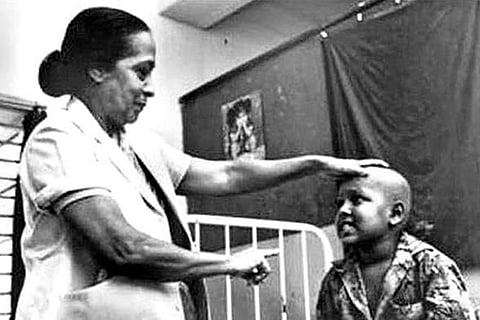

Chennai
The Adyar Cancer Institute, which started functioning in 1954 from a thatched shed with 12 beds and grew into a centre of excellence for oncology, changed public perception of the disease as well as treatment modalities. It was all due to the perseverance of a few doctors. Dr Shanta was one of them.
An MBBS degree from Madras Medical College was not very popular for women in the 1940s. And though her family could boast of two Nobel laureates, it wasn’t an easy accomplishment for young Shanta. But her genes couldn’t be expected to stay silent. Her mother had desired to study nursing, but couldn’t due to early marriage and children in quick succession. Influenced by her and before her teens, Shanta had decided on her life course — to become a doctor. Her family was apprehensive if this delicate girl would be able to weather the exactitude of a medical profession.
She was one among the ten girls in a group of hundred students to enrol for the medical course in MMC. Shanta was a recluse in college. She never attended gatherings and read books in her spare time with no past time diversions nor recreation. Post her graduation, Shanta specialised in gynaecology and obstetrics which then, all female doctors were expected to do.
At about the same time, one of the first women doctors of the country, Muthulakshmi Reddy (personally hurt by the cancer suffering of her sister), convinced the government to bestow a piece of land at Adyar and brought in none lesser than the Prime Minister Jawaharlal Nehru to lay the foundation stone for a cancer institute.
Inspired by the man who would be her mentor, Dr Krishnamurthy, Muthulakshmi’s son, and his pioneering work in cancer care, she declined the offer of a permanent state job at the 100-year-old Egmore Women and Children Hospital (then an ocean of knowledge in that field) and threw away the opportunity of a lucrative practice. She joined the Cancer Institute first as an honorary staff until the Institute offered to pay her Rs 200 per month and residence within the campus. Even she wouldn’t have dreamt, she would live for 66 years in a sparsely furnished two-room apartment on the terrace of the cancer hospital on-call twenty-four hours a day.
When Shanta joined the field of oncology, there was very little knowledge on the origins and treatment of cancer or apt equipment to treat it. The cancer institute was not a charity and perpetually strapped for funds. The government and public apathy was sky high and preferred to donate to causes that showed more results.
Out of the blue, in 1956, the Atomic Energy Commission donated the cancer institute its first Cobalt-60 unit, Eldorado. And suddenly the city took notice of them. “How come a hospital run in huts on the banks of a canal got chosen to receive the cutting edge of cancer treatment?” people wondered.
Shanta qualified herself as one of the leading oncologists in the world. She trained in oncology in Toronto and studied marrow transplantation in the UK. Shanta knew she was battling a giant and took up a multidisciplinary approach, medical, surgical and radiation oncology to put him in place. She was open to all new technologies which would strengthen her arsenal being one of the earliest to use nuclear medical oncology.
But more than the technologies she used, she believed doctors’ responsibility went way beyond healing. More than a doctor and a researcher she was a very caring person. She was known to hold the hands of a terminally ill patient the whole of his last night. She was very meticulous and from the start, protocols were developed for keeping detailed patient records and her cancer registry is the institute’s biggest contribution to the medical field. This was rich research material especially in a subject where there is little information available.
Dr Shanta has devoted considerable effort to the prevention of the disease through tutoring, publicity, field appraisals and screenings. She also strived to change public perception of the disease, especially the extreme fear and hopelessness. When the press referred to corruption as ‘cancer of the society’ she objected to the misuse of the word.
Despite a stroke in 2007, she recovered and worked till her last day. Dr Shanta is one of the very few people honoured with the Padma Shri, Padma Bhushan, and Padma Vibhushan by a grateful nation. She also won the Ramon Magsaysay award.
The world honoured her but she remained the same. A caring human being first. An obsessed doctor fighting the Emperor of Maladies till her last day. Dr Shanta’s career coincided with the greatest unravelling of the mysteries of cancer, bringing it from the superhuman proportions it had, to that of any other disease which modern medicine was apt to mitigate. Today, two-third of cancers can be prevented or cured.
— The writer is a historian and an author
Visit news.dtnext.in to explore our interactive epaper!
Download the DT Next app for more exciting features!
Click here for iOS
Click here for Android